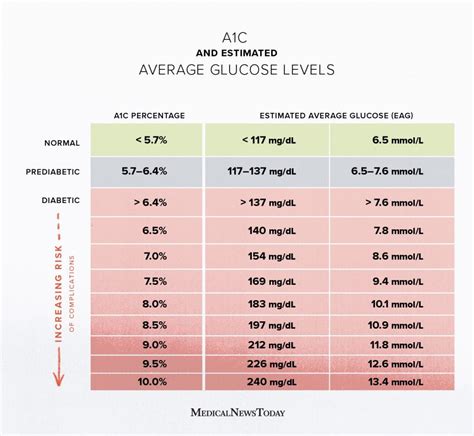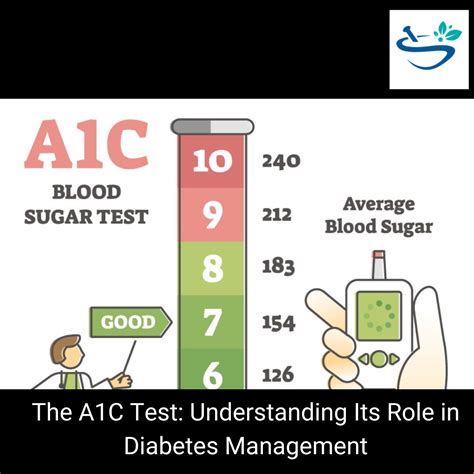Intro
Achieve a healthy A1c range with optimal blood sugar control, improving diabetes management through balanced diets, regular exercise, and stress reduction, targeting A1c levels between 4% to 5.6% for normal glucose metabolism and reduced disease risk.
Maintaining a healthy A1c range is crucial for individuals with diabetes, as it helps to prevent complications and ensure overall well-being. The A1c test, also known as the hemoglobin A1c or HbA1c test, measures the average level of glucose in the blood over the past 2-3 months. For people with diabetes, achieving and maintaining a healthy A1c range is a key goal, as it can help to reduce the risk of long-term complications such as heart disease, kidney damage, and nerve damage.
The importance of maintaining a healthy A1c range cannot be overstated. When blood glucose levels are consistently high, it can lead to damage to the blood vessels and nerves, increasing the risk of complications. On the other hand, maintaining a healthy A1c range can help to prevent these complications and improve overall health outcomes. In addition to reducing the risk of complications, maintaining a healthy A1c range can also improve energy levels, reduce symptoms of diabetes, and enhance overall quality of life.
For individuals with diabetes, understanding the importance of maintaining a healthy A1c range is essential. The American Diabetes Association (ADA) recommends that adults with diabetes aim for an A1c level of less than 7%, while the American Association of Clinical Endocrinologists (AACE) recommends an A1c level of less than 6.5%. However, individual goals may vary depending on factors such as age, health status, and the presence of other medical conditions. It is essential to work with a healthcare provider to determine a personalized A1c goal and develop a plan to achieve and maintain it.
Understanding A1c Range Goals

Normal A1c Range
A normal A1c range is typically considered to be less than 5.7%. This range indicates that blood glucose levels are within a healthy range, and the risk of complications is low. For individuals without diabetes, maintaining an A1c level within this range is essential for overall health and well-being.Diabetic A1c Range
For individuals with diabetes, the A1c range goals are slightly different. The ADA recommends that adults with diabetes aim for an A1c level of less than 7%, while the AACE recommends an A1c level of less than 6.5%. These goals are based on the balance between the benefits of tight blood glucose control and the risks of hypoglycemia and other adverse effects.Benefits of Maintaining a Healthy A1c Range

Reduced Risk of Complications
Maintaining a healthy A1c range can help to reduce the risk of long-term complications such as heart disease, kidney damage, and nerve damage. When blood glucose levels are consistently high, it can lead to damage to the blood vessels and nerves, increasing the risk of complications. By maintaining a healthy A1c range, individuals with diabetes can reduce their risk of these complications and improve overall health outcomes.Improved Energy Levels
Maintaining a healthy A1c range can also improve energy levels and reduce symptoms of diabetes. When blood glucose levels are within a healthy range, the body is able to use glucose for energy, reducing fatigue and improving overall well-being.Steps to Achieve a Healthy A1c Range

Monitoring Blood Glucose Levels
Monitoring blood glucose levels regularly is essential for achieving a healthy A1c range. This involves checking blood glucose levels at regular intervals, typically before meals and before bedtime. By monitoring blood glucose levels, individuals with diabetes can identify patterns and trends, make adjustments to their treatment plan, and achieve better blood glucose control.Following a Healthy Diet and Exercise Plan
Following a healthy diet and exercise plan is also essential for achieving a healthy A1c range. This involves eating a balanced diet that is low in sugar and saturated fat, and high in fiber and healthy protein sources. Regular physical activity, such as walking or swimming, can also help to improve blood glucose control and reduce the risk of complications.Common Challenges and Solutions

Difficulty Sticking to a Healthy Diet and Exercise Plan
Difficulty sticking to a healthy diet and exercise plan is a common challenge for individuals with diabetes. To overcome this challenge, it is essential to work with a registered dietitian or certified diabetes educator to develop a personalized meal plan and exercise program. This can help to ensure that the diet and exercise plan is tailored to individual needs and preferences, making it easier to stick to.Trouble Remembering to Take Medications
Trouble remembering to take medications is another common challenge for individuals with diabetes. To overcome this challenge, it is essential to use a pill box or reminder app to stay on track. This can help to ensure that medications are taken as prescribed, reducing the risk of complications and improving overall health outcomes.What is a healthy A1c range for individuals with diabetes?
+A healthy A1c range for individuals with diabetes is typically considered to be less than 7%, although individual goals may vary depending on factors such as age, health status, and the presence of other medical conditions.
How can I achieve a healthy A1c range?
+Achieving a healthy A1c range requires a combination of lifestyle changes and medical therapies, including monitoring blood glucose levels regularly, following a healthy diet and exercise plan, taking medications as prescribed, and getting regular check-ups with a healthcare provider.
What are the benefits of maintaining a healthy A1c range?
+Maintaining a healthy A1c range has numerous benefits, including reduced risk of complications such as heart disease, kidney damage, and nerve damage, improved energy levels and reduced symptoms of diabetes, and enhanced overall quality of life.
In conclusion, maintaining a healthy A1c range is essential for individuals with diabetes. By understanding the importance of A1c range goals, following a healthy diet and exercise plan, and working with a healthcare provider to develop a personalized treatment plan, individuals with diabetes can achieve and maintain a healthy A1c range, reducing the risk of complications and improving overall health outcomes. We invite you to share your thoughts and experiences on maintaining a healthy A1c range, and to ask any questions you may have on this topic. By working together, we can promote better health outcomes and improve the lives of individuals with diabetes.
